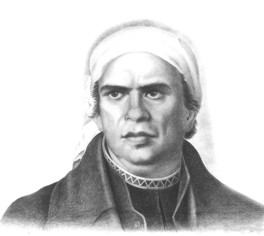A leader of the independence movement, he was born in Valladolid, Michoacán. From 1779 to 1790, he worked at the sugar cane farm of Tahuejo at Apatzingán, perhaps as a clerk or accountant. In 1790, he entered San Nicolás Obispo College in Valladolid, where he studied Latin grammar, rhetoric, philosophy, and ethics. In 1795, at the Tridentino Seminary in the same city, he studied moral theology and philosophy. On April 28, Morelos traveled to Mexico City to take his exams for a bachelor of arts degree at the Real and Pontificia University. On December 13, he received the first shearing and the four minor orders of Valladolid and six days later, he became a sub deacon. In early 1796, he moved to Uruapan as an auxiliary priest and headed the teaching of grammar and rhetoric. In September of that year, he was ordained as a deacon in Valladolid, and on December 21, 1779, he was ordained as a priest in the same city.
In early October 1810, Morelos heard the news of Hidalgo’s uprising and on the nineteenth of that month left to find him. He caught up with Hidalgo the next day and spoke with him at Charo e Indaparapeo. Morelos was put in charge of raising arms on the south coast. On November 13, Morelos and his troops engaged the enemy for the first time, facing the royalist forces of Luis Calatayud at El Veladero. On November 17, Morelos issued an edict suppressing slavery, castes and community funds. His activities worried the viceroy, who sent Francisco París to fight him. París engaged him on December 8 at El Veladero but was rebuffed.
On May 3, 1811, Morelos named Hermenegildo Galeana as his lieutenant. On May 26, Morelos conquered Tixtla, where Vicente Guerrero joined him. It was there that he published an edict on the issuance of a domestic copper currency and wrote to Ignacio López Rayón on the formation of a council for the insurgency. On December 18, Mariano Matamoros joined him, and on February 18, 1812, Morelos nearly fell into the hands of Calleja at Cuautla. On August 10, Morelos arrived in Tehuacán, where he reorganized and trained his troops and took control of the rebel movement. In September the same year, he named Matamoros as second in command and Galeana as marshal.
On October 18, Porlier and Luis del Águila defeated Morelos at Ojo de Agua. He conquered Orizaba on the twenty-ninth, but on his return to Tehuacán, Luis del Águila defeated him again at Puente Colorado on the Acutzingo Crests. Morelos took Oaxaca on November 25 and there began the publication of the newspaper Sud. On April 12, 1813, he seized Acapulco and on August 31 headed to Chilpancingo, where on September 14 he opened the Congress with the election of deputies and the reading of his Sentimientos de la Nación (Sentiments of the Nation. The following day, the Congress elected him Supreme Commander in charge of the executive branch and on November 6, issued its Act of Independence.
On December 23, Ciriaco de Llano and Agustín de Iturbide chased Morelos out of the Santa María hills. He withdrew to Chupío and Puruarán, where he suffered another defeat. In Tlacotepec, the Congress dismissed him as Supreme Commander. He suffered another defeat at Las Ánimas. He later marched on Tecpan and Acapulco, and the Congress removed him from the executive branch on March 14, 1814. On October 11, Morelos met up with José María Cos at Santa Clara del Cobre. He continued on to Ario, pursued by the royalists, and arrived at Apatzingán, where the Congress published his Constitutional Decree for the Liberty of Mexican America.
The Congress decided to move to Tehuacán due to the royalist pursuit, and Morelos took charge of holding it. On September 28, 1815, he left for Huetamo, Cutzamala, and Tlachapa, and on November 2 arrived in Atenango del Río. The next day, he arrived in Temalaca and on the fifth, as he was heading toward Pilcaya, he was attacked by Concha and taken prisoner by Matías Carrasco, a former insurgent. He arrived in Mexico City on the twenty-second, and on the twenty-seventh, he was declared a heretic and demoted in rank. On December 20, Calleja sentenced him to death. Morelos was shot at San Cristóbal Ecatepec.
In 1828, the city where Morelos was born received the name Morelia. In 1869, Benito Juárez decreed the founding of the state that bears his name. On September 16, 1925, his remains were taken to the Independence Column.
Source: Diccionario Porrúa de Historia, Biografía y Geografía de México.
